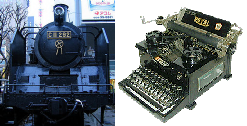Oct 25 2011
The steam locomotive and the typewriter
The first draft of my book Working with Machines contained a chapter that was a post-mortem on two obsolete machines, which was cut on the grounds that, unlike all other chapters, it was not actionable for the reader.
Its abstract is as follows:
The steam locomotive and the typewriter are icons of the industrial age, and their parallel histories show different aspects of the human experience of working with machines. The steam locomotive is fondly remembered; the typewriter, all but forgotten except for the QWERTY keyboard. The steam engine participated in the development of every industrial economy, but the typewriter played no major role in Japan. The typewriter did not demonstrably improve the productivity or quality of office output, but was adopted only because of its image of modernity.
Locomotive driver was a prestigious position for a manual laborer, but typist never was. Compared to electrics and diesels, the steam locomotive had a cab that was exposed to the elements and to the heat of the firebox and therefore uncomfortable, difficult to operate, and dangerous. Yet engineers and firemen preferred it to the tedium and loneliness of modern locomotives. Automatic machines that require human attention only when they malfunction are also in airplanes and in manufacturing plants, challenging the job designer to keep the operator alert and used efficiently.
As the typewriter prints one keystroke at a time, typists were always busy with a single machine and determined both its productivity and output quality. Typists worked in comfortable places, but under pressure, and faced the long-term hazards of sedentary work. The typewriter’s main legacy is that a society can make a long-term investment in machines whose tangible benefits do not obviously exceed their costs.
Click here for a pdf file of the entire chapter.

Let’s talk about automation/autonomation/jidoka | Michel Baudin's Blog
November 18, 2011 @ 10:56 pm
[…] with Machines started with the following historical background, which was edited out like the chapter on locomotives and typewriters, on the ground that it contained no actionable recommendations. In this blog, I can let you be the […]